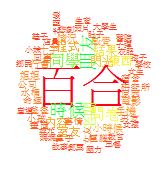講題分享 - 用 R 進行中文 text Mining (作者:陳嘉葳@Taiwan R User Group)
本文使用的分析方法,目前僅能在Windows上測試成功。
簡介
現今網路上有大量文字資料,例如 ptt, facebook, 或 mobile01等討論網站上都有大量文字留言, 由於這些資料繁多雜亂, 我們可藉由文字探勘技術萃取出有用的訊息, 讓人們有效率掌握這些網路文字所提供的訊息。而R語言是一款非常適合資料分析的工具,有一系列文字探勘的套件可供使用,本文將簡單介紹中文文字探勘套件的使用方法。
安裝需要工具
我的環境: Windows 7 + R 版本 2.15.3 + RStudio 0.98.484
安裝以下套件
install.packages("rJava")
install.packages("Rwordseg", repos="http://R-Forge.R-project.org")
install.packages("tm")
install.packages("tmcn", repos="http://R-Forge.R-project.org", type="source")
install.packages("wordcloud")
install.packages("XML")
install.packages("RCurl")Windows上安裝rJava的注意事項:
- 將jvm.dll加到環境變數PATH之中
- 注意java的版本(32-bit or 64-bit)必須要和R一致 (Windows binary)之後再安裝,以避免
抓取ptt笨版文章列表
我們以分析ptt笨版文章為範例, 首先到ptt web 版抓取文章的url連結。 我們利用 RCurl套件的 getURL和 XML套件的 htmlParseApply 抓取笨版文章列表的 html網頁, 再用xpathSApply 去擷取出所有文章的url連結並儲存。 或是可以到已下載ptt笨版文章
library(XML)
library(RCurl)
data <- list()
for( i in 1058:1118){
tmp <- paste(i, '.html', sep='')
url <- paste('www.ptt.cc/bbs/StupidClown/index', tmp, sep='')
html <- htmlParse(getURL(url))
url.list <- xpathSApply(html, "//div[@class='title']/a[@href]", xmlAttrs)
data <- rbind(data, paste('www.ptt.cc', url.list, sep=''))
}
data <- unlist(data)下載列表中的笨版文章之後,接著才開始利用所有文章的url連結去抓所有文章的html網頁, 並用xpathSApply去解析出文章的內容並儲存。
getdoc <- function(line){
start <- regexpr('www', line)[1]
end <- regexpr('html', line)[1]
if(start != -1 & end != -1){
url <- substr(line, start, end+3)
html <- htmlParse(getURL(url), encoding='UTF-8')
doc <- xpathSApply(html, "//div[@id='main-content']", xmlValue)
name <- strsplit(url, '/')[[1]][4]
write(doc, gsub('html', 'txt', name))
}
}開始下載文章
先用 setwd(填入資料夾位置) 這指令, 選定文件下載位置
或是用 getwd()確定目前的工作資料夾位置
sapply(data, getdoc) 開始文字處理
首先載入以下text mining 套件
library(tm)
library(tmcn)## # tmcn Version: 0.1-2library(Rwordseg)## Loading required package: rJava
## # Version: 0.2-1匯入剛才抓完的笨版文章,doc 是儲存下載ptt文章的資料夾, 這些文章變成我們分析的語料庫。
d.corpus <- Corpus(DirSource("doc"), list(language = NA))進行數據清理
1 清除標點符號, 數字
d.corpus <- tm_map(d.corpus, removePunctuation)
d.corpus <- tm_map(d.corpus, removeNumbers)2 清除大小寫英文與數字
d.corpus <- tm_map(d.corpus, function(word) {
gsub("[A-Za-z0-9]", "", word)
})進行中文斷詞
首先,由於ptt有自己獨特的詞彙,例如發文不附沒圖、沒圖沒真相...等等,因此我們另外安裝 ptt 常用詞彙來協助斷詞。ptt常用詞彙可以從搜狗細胞辭庫下載 。
words <- readLines("http://wubi.sogou.com/dict/download_txt.php?id=9182")
words <- toTrad(words)
insertWords(words)接著,我們利用我們 Rwordseg套件裡的segmentCN來進行斷詞。Rwordseg是李艦所撰寫的R套件,利用rJava去連結java分詞工具ansj來進行斷詞。 另外,斷詞後的詞彙有詞性,例如動詞、名詞、形容詞、介係詞等等,我們只挑出名詞來進行分析。
d.corpus <- tm_map(d.corpus[1:100], segmentCN, nature = TRUE)
d.corpus <- tm_map(d.corpus, function(sentence) {
noun <- lapply(sentence, function(w) {
w[names(w) == "n"]
})
unlist(noun)
})
d.corpus <- Corpus(VectorSource(d.corpus))接著進行清除停用字符,停用字符指的是一些文章中常見的單字,但卻無法提供我們資訊的冗字。例如有些、以及、因此...等等字詞。
myStopWords <- c(stopwordsCN(), "編輯", "時間", "標題", "發信", "實業", "作者")
d.corpus <- tm_map(d.corpus, removeWords, myStopWords)我們可以看看有哪些停用字符,這裡抽出前20個停用字符來看
head(myStopWords, 20)## [1] "第二" "一番" "一直" "一<U+4E2A>" "一些" "<U+8BB8>多"
## [7] "种" "有的是" "也就是<U+8BF4>" "末" "啊" "阿"
## [13] "哎" "哎呀" "哎<U+54DF>" "唉" "俺" "俺<U+4EEC>"
## [19] "按" "按照"建立 TermDocumentMatrix
中文斷詞結束後,我們用矩陣將結果儲存起來。TermDocumentMatrix 指的是關鍵字為列,文件是行的矩陣。儲存的數字是關鍵字在這些文件中出現的次數。其中 wordLengths=c(2,Inf) 表示我們挑至少兩個字的詞。
tdm <- TermDocumentMatrix(d.corpus, control = list(wordLengths = c(2, Inf)))我們可以看看TermDocumentMatrix裡面,前兩篇文章的前10個關鍵字
inspect(tdm[1:10, 1:2])## A term-document matrix (10 terms, 2 documents)
##
## Non-/sparse entries: 3/17
## Sparsity : 85%
## Maximal term length: 3
## Weighting : term frequency (tf)
##
## Docs
## Terms M.1384834727.A.0CB.txt M.1384838698.A.957.txt
## 一生 0 0
## 一家 1 0
## 一家子 0 0
## 一線 0 0
## 人士 0 0
## 人才 0 0
## 人中 0 0
## 人文 0 0
## 人民 0 1
## 人生 0 2畫出關鍵字詞雲
我們利用 wordcloud 套件,畫出在所有文件中出現次數超過10次的名詞。出現次數越多,字體就會呈現越大。
library(wordcloud)m1 <- as.matrix(tdm)
v <- sort(rowSums(m1), decreasing = TRUE)
d <- data.frame(word = names(v), freq = v)
wordcloud(d$word, d$freq, min.freq = 10, random.order = F, ordered.colors = F,
colors = rainbow(length(row.names(m1))))
plot of chunk unnamed-chunk-13
這邊看到百合出現次數非常多,原因是因為一位叫小百合的網友所發的po文被鄉民推爆,留言當中也重複出現小百合的緣故。
尋找關鍵字之間的關聯
當我們利用wordcloud 知道哪些關鍵字常出現後,接著可能想知道哪些字與它有關聯。 因此我們先建出DocumentTermMatrix,這是以文件名稱為列,關鍵字為欄的矩陣。
d.dtm <- DocumentTermMatrix(d.corpus, control = list(wordLengths = c(2, Inf)))
inspect(d.dtm[1:10, 1:2])## A document-term matrix (10 documents, 2 terms)
##
## Non-/sparse entries: 1/19
## Sparsity : 95%
## Maximal term length: 2
## Weighting : term frequency (tf)
##
## Terms
## Docs 一生 一家
## M.1384834727.A.0CB.txt 0 1
## M.1384838698.A.957.txt 0 0
## M.1384840050.A.414.txt 0 0
## M.1384840304.A.EF5.txt 0 0
## M.1384842495.A.5B8.txt 0 0
## M.1384842609.A.A5B.txt 0 0
## M.1384847473.A.6A5.txt 0 0
## M.1384847771.A.729.txt 0 0
## M.1384848469.A.AD8.txt 0 0
## M.1384849471.A.B71.txt 0 0可以用 findFreqTerms 看看在所有文件裡出現30次以上的關鍵字有哪些。
findFreqTerms(d.dtm, 30)## [1] "同學" "百合" "老闆" "朋友" "東西" "時候" "閃光" "問卷" "結果"再來可以用 findAssocs 找出最常與"同學"關程度0.5以上的關鍵字。
findAssocs(d.dtm, "同學", 0.5)## 同學.原因
## 0.56結尾
以上我們介紹了如何將中文文章進行清理、斷詞等處理,最後轉換成矩陣,再進行一些簡單分析與繪圖。本文介紹之操作,還可以繼續進行關鍵字分群、主題模型、情緒分析等進階應用,有興趣繼續深入, 可以自行搜尋 tm, tmcn, Rwordseg 這三個套件,可以發現許多資源自行學習。
作者
- 陳嘉葳 : 國立高雄大學資管所, Kaohsiung useR! Meetup, Taiwan R User Group